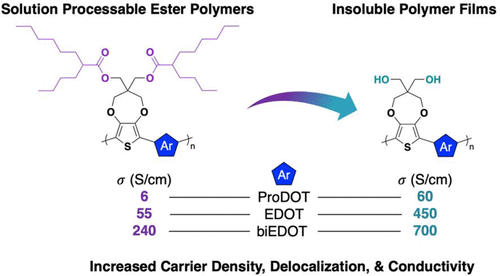- 化学者とエンジニアが協力して、強靭なポリマー骨格から非導電性の側鎖を洗い流し、強力な導電性プラスチックを作り出すプロセスを開発しました。
Chemists and engineers collaborate on process that washes away nonconductive side chains from a robust polymer backbone to create a powerful conductive plastic.
- 可溶性前駆体ポリマーの側鎖除去によるPEDOT(OH)膜の金属的電荷輸送の実現 Metal-like Charge Transport in PEDOT(OH) Films by Post-processing Side Chain Removal from a Soluble Precursor Polymer
- 共役系高分子の後処理による側鎖除去で電気伝導性が大幅に向上 Significant Enhancement of the Electrical Conductivity of Conjugated Polymers by Post-Processing Side Chain Removal
化学者とエンジニアが協力して、強靭なポリマー骨格から非導電性の側鎖を洗い流し、強力な導電性プラスチックを作り出すプロセスを開発しました。 Chemists and engineers collaborate on process that washes away nonconductive side chains from a robust polymer backbone to create a powerful conductive plastic.
2022-12-01 ジョージア工科大学
その結果、ウェアラブルバイオセンサー、有機太陽電池、仮想現実や拡張現実のディスプレイやメガネなど、新しい種類の柔軟で透明な電子デバイスを生み出すことができる。
電荷を運ぶことができるプラスチックフィルムを作るために、化学者は、既知のポリマー骨格から始める。この場合、PEDOTと呼ばれる一般的なポリマーで、ある種の製剤として産業界で使われているものである。PEDOTは電気を通すのに優れていますが、不溶性なのでそのままでは使いにくいのです。しかし、PEDOTに側鎖をつけると、溶かして印刷用インクやスプレー塗料のように使うことができるようになる。そのため、使いやすく、塗りやすい。しかし、その側鎖は本来ワックス状の物質で、ワックスは電気伝導性があまりよくない。
つまり、側鎖を持つポリマーを作り、それを印刷またはスプレーして塗布し、側鎖を化学的に切断し、一般的な工業用溶剤で洗い流す。最終的な変換工程を経て、柔軟で導電性の高いフィルムができあがり、水や他の溶媒にも侵されない安定したフィルムになった。
研究者たちは、1cmあたり1,000シーメンス以上の導電性を持ち、工業用の簡単な印刷方法と工業界の人々が好む溶剤を使って加工でき、しかも導電性に加えて光透過性もあるポリマーを作る方法を考え出したである。
研究チームは、まず『Journal of the American Chemical Society』誌でこのアイデアを説明し、機能することを証明した。そして最近、ドイツの化学専門誌『Angewandte Chemie』誌で、導電性を最大限に高めるために設計を最適化した研究を発表している。
<関連情報>
- https://coe.gatech.edu/news/2022/12/going-back-basics-yields-printable-transparent-plastic-thats-highly-conductive
- https://onlinelibrary.wiley.com/doi/10.1002/anie.202211600
- https://pubs.acs.org/doi/10.1021/jacs.1c11558
可溶性前駆体ポリマーの側鎖除去によるPEDOT(OH)膜の金属的電荷輸送の実現 Metal-like Charge Transport in PEDOT(OH) Films by Post-processing Side Chain Removal from a Soluble Precursor Polymer
James F. Ponder Jr.,Shawn A. Gregory,Amalie Atassi,Abigail A. Advincula,Joshua M. Rinehart,Guillaume Freychet,Gregory M. Su,Shannon K. Yee,John R. Reynolds
Angewandte Chemie Published: 21 October 2022
DOI:https://doi.org/10.1002/anie.202211600
Abstract
Functionalization of poly(3,4-ethylenedioxythiophene) (PEDOT) with ester-based side chains allow for solution processing and moderate electrical conductivity. Hydrolysis of these side chains leaves hydroxymethyl functional groups on the polymer, increases the relative amount of electroactive material, significantly increases electrical conductivity to greater than 1000 S cm−1, and changes the transport mechanism from hopping-like to metal-like.

Abstract
Herein, a route to produce highly electrically conductive doped hydroxymethyl functionalized poly(3,4-ethylenedioxythiophene) (PEDOT) films, termed PEDOT(OH) with metal-like charge transport properties using a fully solution processable precursor polymer is reported. This is achieved via an ester-functionalized PEDOT derivative [PEDOT(EHE)] that is soluble in a range of solvents with excellent film-forming ability. PEDOT(EHE) demonstrates moderate electrical conductivities of 20–60 S cm−1 and hopping-like (i.e., thermally activated) transport when doped with ferric tosylate (FeTos3). Upon basic hydrolysis of PEDOT(EHE) films, the electrically insulative side chains are cleaved and washed from the polymer film, leaving a densified film of PEDOT(OH). These films, when optimally doped, reach electrical conductivities of ≈1200 S cm−1 and demonstrate metal-like (i.e., thermally deactivated and band-like) transport properties and high stability at comparable doping levels.
共役系高分子の後処理による側鎖除去で電気伝導性が大幅に向上 Significant Enhancement of the Electrical Conductivity of Conjugated Polymers by Post-Processing Side Chain Removal
James F. Ponder Jr., Shawn A. Gregory, Amalie Atassi, Akanksha K. Menon, Augustus W. Lang, Lisa R. Savagian, John R. Reynolds, and Shannon K. Yee
Journal of the American Chemical Society Published:January 10, 2022
DOI:https://doi.org/10.1021/jacs.1c11558

Abstract
The processability and electronic properties of conjugated polymers (CPs) have become increasingly important due to the potential of these materials in redox and solid-state devices for a broad range of applications. To solubilize CPs, side chains are needed, but such side chains reduce the relative fraction of electroactive material in the film, potentially obstructing π–π intermolecular interactions, localizing charge carriers, and compromising desirable optoelectronic properties. To reduce the deleterious effects of side chains, we demonstrate that post-processing side chain removal, exemplified here via ester hydrolysis, significantly increases the electrical conductivity of chemically doped CP films. Beginning with a model system consisting of an ester functionalized ProDOT copolymerized with a dimethylProDOT, we used a variety of methods to assess the changes in polymer film volume and morphology upon hydrolysis and resulting active material densification. Via a combination of electrochemistry, X-ray photoelectron spectroscopy, and charge transport models, we demonstrate that this increase in electrical conductivity is not due to an increase in degree of doping but an increase in charge carrier density and reduction in carrier localization that occurs due to side chain removal. With this improved understanding of side chain hydrolysis, we then apply this method to high-performance ProDOT-alt-EDOTx copolymers. After hydrolysis, these ProDOT-alt-EDOTx copolymers yield exceptional electrical conductivities (∼700 S/cm), outperforming all previously reported oligoether-/glycol-based CP systems. Ultimately, this methodology advances the ability to solution process highly electrically conductive CP films.



